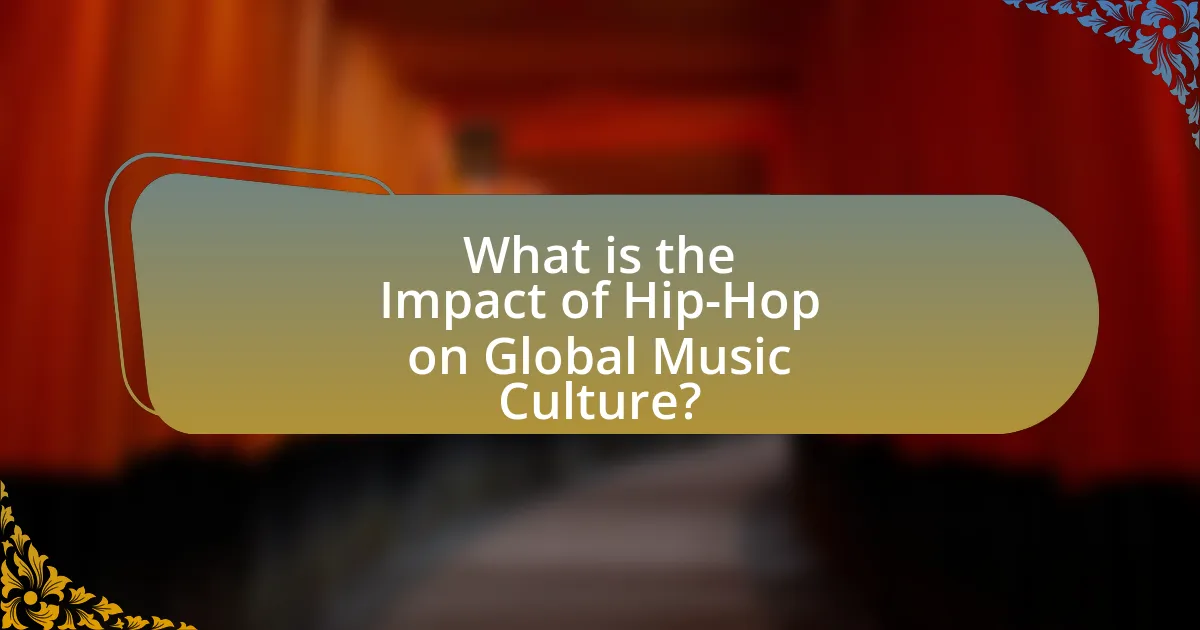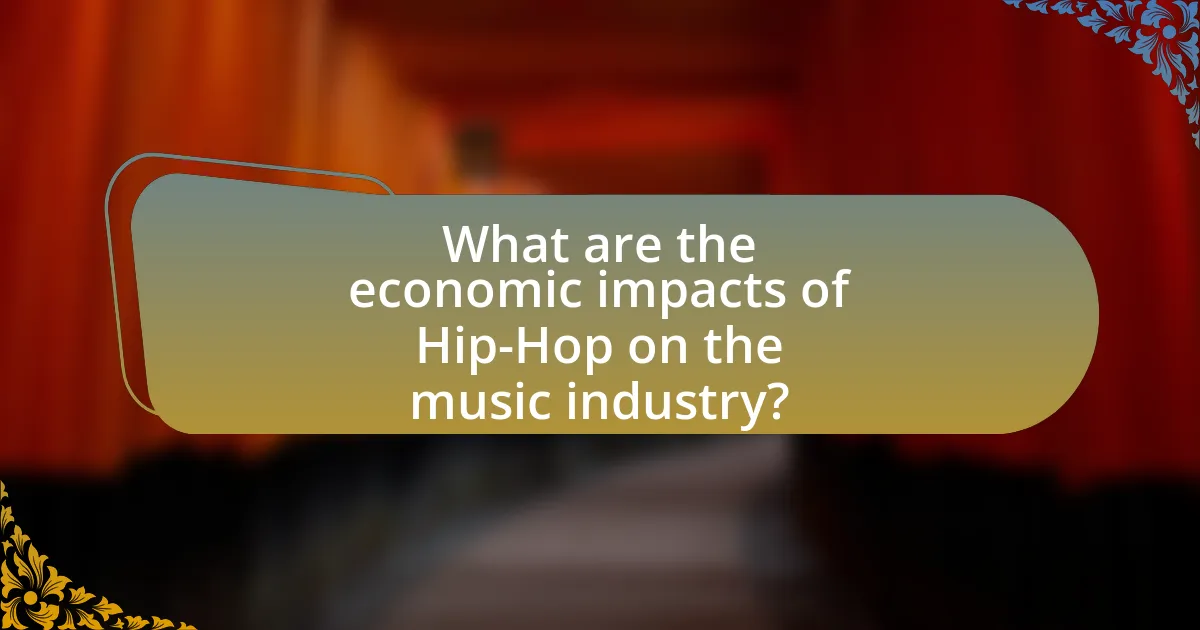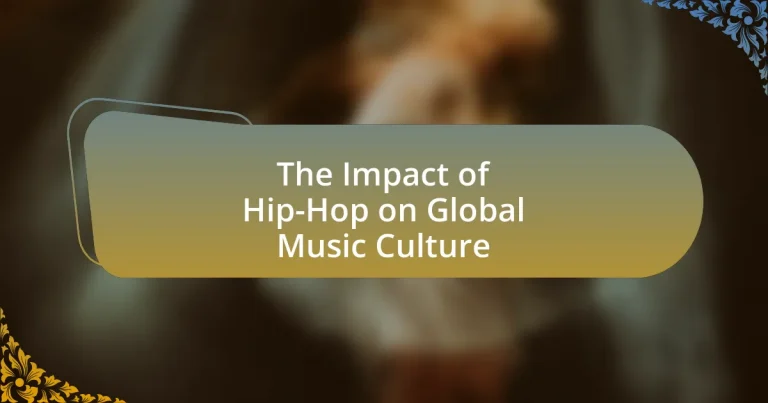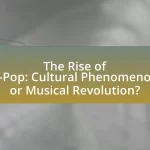Hip-Hop is a cultural movement that originated in the 1970s in the Bronx, New York, and has since evolved into a dominant force in global music culture. This article examines Hip-Hop’s significant impact on various music genres, its role as a platform for social commentary, and its influence on identity and community. Key historical milestones, regional adaptations, and the economic implications of Hip-Hop are discussed, alongside its contributions to social and political movements. The article also addresses challenges faced by Hip-Hop artists in the global music scene and offers insights into best practices for engaging with Hip-Hop culture authentically.

What is the Impact of Hip-Hop on Global Music Culture?
Hip-Hop has significantly influenced global music culture by shaping genres, styles, and social movements worldwide. Originating in the 1970s in the Bronx, New York, Hip-Hop has evolved into a dominant cultural force, impacting various music genres such as pop, R&B, and electronic music. The genre’s elements, including rapping, DJing, and breakdancing, have been adopted and adapted by artists across the globe, leading to the emergence of regional styles like UK Grime, French Rap, and Latin Trap.
Moreover, Hip-Hop serves as a platform for social commentary, addressing issues such as race, inequality, and identity, which resonates with diverse audiences. The global reach of Hip-Hop is evidenced by its presence in international music charts, collaborations between artists from different countries, and the proliferation of Hip-Hop festivals worldwide. According to a 2021 report by the International Federation of the Phonographic Industry, Hip-Hop is one of the most consumed music genres globally, highlighting its pervasive influence on contemporary music culture.
How did Hip-Hop originate and evolve over time?
Hip-Hop originated in the 1970s in the South Bronx, New York City, as a cultural movement encompassing music, dance, art, and fashion. It evolved from block parties where DJs would play funk and soul records, creating a new sound by isolating breaks and beats, which led to the emergence of rapping as a vocal style. The genre gained popularity through influential artists like DJ Kool Herc, who is credited with pioneering breakbeat DJing, and Grandmaster Flash, who developed innovative turntable techniques.
As Hip-Hop spread throughout the 1980s and 1990s, it diversified into various sub-genres, including gangsta rap, conscious rap, and alternative hip-hop, reflecting different social issues and cultural experiences. The introduction of music videos and the rise of platforms like MTV further propelled its reach, making Hip-Hop a dominant force in global music culture. By the 2000s, Hip-Hop had become a multi-billion dollar industry, influencing fashion, language, and lifestyle worldwide, with artists like Jay-Z and Eminem achieving unprecedented commercial success.
The evolution of Hip-Hop continues today, with new artists and styles emerging, showcasing its adaptability and enduring impact on music and culture globally.
What are the key historical milestones in Hip-Hop’s development?
The key historical milestones in Hip-Hop’s development include the emergence of DJ Kool Herc’s block parties in the Bronx in 1973, which marked the genre’s birth. In 1979, the Sugarhill Gang released “Rapper’s Delight,” the first commercially successful hip-hop single, bringing the genre into mainstream music. The 1980s saw the rise of influential artists like Run-D.M.C. and Public Enemy, who expanded hip-hop’s reach and cultural significance. The 1990s introduced the East Coast-West Coast rivalry, highlighted by artists such as The Notorious B.I.G. and Tupac Shakur, which shaped the genre’s narrative. The 2000s and beyond witnessed the globalization of hip-hop, with artists like Jay-Z and Eminem achieving international fame, further solidifying hip-hop’s impact on global music culture.
How has Hip-Hop influenced other music genres?
Hip-Hop has significantly influenced various music genres by introducing rhythmic vocal styles, sampling techniques, and a focus on lyrical storytelling. For instance, genres like pop, R&B, and rock have incorporated Hip-Hop elements, evident in collaborations between artists such as Jay-Z and Linkin Park, which blended rap with rock, creating a new sound. Additionally, the use of sampling in Hip-Hop has transformed electronic music, as seen in the works of artists like Daft Punk, who have drawn inspiration from Hip-Hop beats and production methods. This cross-genre influence has led to the emergence of subgenres like trap and reggaeton, which integrate Hip-Hop’s rhythmic patterns and lyrical styles, showcasing its pervasive impact on global music culture.
Why is Hip-Hop considered a global phenomenon?
Hip-Hop is considered a global phenomenon because it transcends cultural and geographical boundaries, influencing music, fashion, and social movements worldwide. Originating in the Bronx in the 1970s, Hip-Hop has evolved into a dominant cultural force, with artists from diverse backgrounds adopting its elements, such as rapping, DJing, and breakdancing. The genre’s global reach is evidenced by its presence in various countries, where local artists incorporate regional languages and styles, creating unique sub-genres. For instance, K-Pop artists in South Korea often blend Hip-Hop with pop music, while artists in France and Brazil have developed their own distinct interpretations. Additionally, Hip-Hop’s themes of resistance, empowerment, and social justice resonate universally, making it a powerful tool for expression and connection across different cultures.
What cultural exchanges have occurred due to Hip-Hop’s spread?
Hip-Hop’s spread has led to significant cultural exchanges, including the fusion of musical styles, language, and fashion across diverse communities worldwide. For instance, in countries like Brazil and South Africa, local artists have incorporated traditional rhythms and languages into Hip-Hop, creating unique subgenres such as Brazilian funk and Kwaito. This blending of cultures has facilitated cross-cultural collaborations, exemplified by artists like Akon and Shakira, who have successfully merged Hip-Hop with their native musical traditions. Additionally, Hip-Hop has influenced global fashion trends, with streetwear becoming a universal style, reflecting the genre’s roots in urban culture. These exchanges illustrate how Hip-Hop serves as a platform for cultural dialogue and innovation, reshaping identities and artistic expressions globally.
How do different regions interpret and adapt Hip-Hop?
Different regions interpret and adapt Hip-Hop by infusing local languages, cultural themes, and social issues into the genre. For instance, in France, artists like IAM and NTM incorporate elements of French history and multiculturalism, reflecting the country’s diverse society. In Brazil, artists such as Criolo blend Hip-Hop with samba and bossa nova, addressing social inequality and urban life. In Japan, the genre is adapted through unique visual aesthetics and local dialects, with artists like Nujabes merging Hip-Hop with jazz influences. These adaptations demonstrate how Hip-Hop serves as a platform for regional expression, allowing artists to address local narratives while maintaining the genre’s core elements.
What are the main elements of Hip-Hop culture?
The main elements of Hip-Hop culture are rapping, DJing, graffiti art, breakdancing, and knowledge of the culture. Rapping involves rhythmic vocal delivery of lyrics, while DJing focuses on mixing and manipulating music tracks. Graffiti art serves as a visual expression of the culture, often conveying social and political messages. Breakdancing, or b-boying, is a dynamic dance style that emphasizes athleticism and creativity. Knowledge encompasses the understanding of Hip-Hop’s history, values, and social issues. These elements collectively define Hip-Hop culture and contribute to its global influence on music and society.
What role do lyrics play in Hip-Hop’s cultural impact?
Lyrics in Hip-Hop serve as a powerful medium for storytelling, social commentary, and cultural expression, significantly shaping its cultural impact. They articulate the experiences, struggles, and aspirations of marginalized communities, often addressing issues such as racism, poverty, and violence. For instance, songs like “Fight the Power” by Public Enemy and “Alright” by Kendrick Lamar have become anthems for social justice movements, illustrating how lyrics can mobilize and inspire collective action. Furthermore, the lyrical complexity and wordplay in Hip-Hop have influenced language and communication styles globally, contributing to its pervasive cultural footprint.
How do dance and visual art contribute to Hip-Hop culture?
Dance and visual art are integral components of Hip-Hop culture, serving as vital forms of expression and communication. Dance styles such as breakdancing and locking not only showcase individual creativity but also foster community and competition within the Hip-Hop scene, as evidenced by the global popularity of events like the Red Bull BC One, which highlights the significance of dance battles in Hip-Hop culture. Visual art, particularly graffiti, acts as a powerful medium for social commentary and identity, with artists like Jean-Michel Basquiat and Keith Haring drawing from Hip-Hop aesthetics to challenge societal norms and convey messages of resistance. Together, these art forms enrich Hip-Hop culture by promoting artistic innovation and cultural dialogue, reinforcing its role as a dynamic and evolving movement.

How does Hip-Hop influence social and political movements?
Hip-Hop influences social and political movements by serving as a powerful platform for marginalized voices and facilitating activism. Through lyrics and performances, artists address issues such as systemic racism, police brutality, and economic inequality, mobilizing communities and raising awareness. For instance, the song “Fight the Power” by Public Enemy became an anthem for the civil rights movement, highlighting the struggles faced by African Americans. Additionally, the Black Lives Matter movement has utilized Hip-Hop culture to amplify its message, with artists like Kendrick Lamar and J. Cole addressing social justice themes in their music. This intersection of Hip-Hop and activism demonstrates the genre’s role in shaping public discourse and inspiring collective action.
What messages are conveyed through Hip-Hop music?
Hip-Hop music conveys messages of social justice, identity, resilience, and empowerment. Artists often address systemic issues such as racism, poverty, and inequality, reflecting the struggles and experiences of marginalized communities. For example, tracks like “Fight the Power” by Public Enemy explicitly challenge societal norms and advocate for civil rights. Additionally, Hip-Hop serves as a platform for self-expression and cultural identity, allowing artists to share personal narratives and connect with listeners on a deeper level. The genre’s roots in African American culture and its evolution globally highlight its role in fostering community and solidarity among diverse groups.
How has Hip-Hop been used as a tool for activism?
Hip-Hop has been used as a tool for activism by addressing social issues, promoting political awareness, and mobilizing communities. Artists like Public Enemy and N.W.A. have highlighted systemic racism and police brutality through their lyrics, which resonate with marginalized groups. For instance, the song “Fight the Power” by Public Enemy became an anthem for the civil rights movement, emphasizing the need for social justice. Additionally, contemporary artists such as Kendrick Lamar and J. Cole continue this tradition by discussing topics like inequality and mental health, further engaging listeners in activism. The genre’s ability to reach a wide audience through music and culture makes it a powerful medium for advocacy and change.
What are some notable examples of Hip-Hop influencing social change?
Hip-Hop has significantly influenced social change through various movements and initiatives. One notable example is the “Black Lives Matter” movement, which has been amplified by artists like Kendrick Lamar and J. Cole, who address systemic racism and police brutality in their lyrics. Kendrick Lamar’s song “Alright” became an anthem for protests, encapsulating the struggles faced by the Black community and promoting resilience.
Another example is the “Hip-Hop for Change” organization, which uses music to educate and empower marginalized communities, focusing on issues like poverty and social justice. Additionally, the “Vote or Die” campaign, initiated by P. Diddy in 2004, aimed to increase voter turnout among young people, highlighting the importance of civic engagement.
These instances demonstrate how Hip-Hop serves as a platform for activism, raising awareness and inspiring action on critical social issues.
How does Hip-Hop shape identity and community?
Hip-Hop shapes identity and community by providing a platform for self-expression and cultural representation. Through its lyrical content, Hip-Hop addresses social issues, personal experiences, and collective struggles, allowing individuals to connect with their own identities and those of others in their community. For instance, studies show that Hip-Hop culture fosters a sense of belonging among marginalized groups, as it often reflects their realities and aspirations. Additionally, events like block parties and cyphers create communal spaces where individuals can share their talents and stories, reinforcing social bonds. The genre’s global reach further amplifies diverse voices, contributing to a shared cultural identity that transcends geographical boundaries.
What role does Hip-Hop play in youth culture?
Hip-Hop plays a significant role in youth culture by serving as a powerful medium for self-expression, identity formation, and social commentary. It influences fashion, language, and attitudes among young people, often reflecting their experiences and aspirations. For instance, a study by the Pew Research Center found that 62% of teens feel that Hip-Hop music helps them express their feelings and connect with their peers. Additionally, Hip-Hop culture promotes creativity through dance, art, and music production, fostering a sense of community and belonging among youth.
How does Hip-Hop foster a sense of belonging among its followers?
Hip-Hop fosters a sense of belonging among its followers by creating a shared cultural identity and community through its music, language, and social messages. The genre often addresses themes of struggle, resilience, and empowerment, resonating with individuals who face similar societal challenges. For instance, the use of storytelling in Hip-Hop allows artists to express personal and collective experiences, which helps listeners feel understood and connected. Additionally, Hip-Hop culture promotes inclusivity through events like cyphers and battles, where participants engage in collaborative and competitive expressions of creativity, reinforcing social bonds. Research indicates that participation in Hip-Hop communities can lead to increased social cohesion and support networks, further solidifying the sense of belonging among its followers.

What are the economic impacts of Hip-Hop on the music industry?
Hip-Hop significantly impacts the music industry economically by generating substantial revenue through album sales, streaming, and live performances. In 2020, the global Hip-Hop music market was valued at approximately $9 billion, reflecting its dominance in the music genre landscape. Additionally, Hip-Hop artists frequently collaborate with brands for endorsements and sponsorships, further contributing to their financial success and the industry’s overall growth. The genre’s influence extends to fashion and lifestyle sectors, creating a multi-billion dollar ecosystem that intertwines music with consumer culture. This economic footprint underscores Hip-Hop’s role as a driving force in the contemporary music industry.
How has Hip-Hop changed the landscape of music production and distribution?
Hip-Hop has fundamentally transformed music production and distribution by democratizing access to music creation and enabling independent artists to reach global audiences. The advent of affordable music production software and hardware, such as digital audio workstations (DAWs) like Ableton Live and FL Studio, has allowed aspiring producers to create high-quality tracks without the need for expensive studio time. This shift is evidenced by the rise of platforms like SoundCloud and Bandcamp, which have empowered artists to distribute their music directly to fans, bypassing traditional record label gatekeeping. According to a 2020 report by the Recording Industry Association of America (RIAA), Hip-Hop/Rap became the most consumed genre in the U.S., highlighting its significant influence on mainstream music consumption patterns.
What are the financial implications for artists in the Hip-Hop genre?
Artists in the Hip-Hop genre face significant financial implications, including income variability, revenue generation from multiple streams, and the impact of digital distribution. Income variability arises from the unpredictable nature of music sales and streaming royalties, which can fluctuate based on market trends and audience engagement. Revenue generation is often diversified through live performances, merchandise sales, and brand partnerships, with live shows being a primary income source; for instance, top Hip-Hop artists can earn millions per concert. Digital distribution has transformed revenue models, with platforms like Spotify and Apple Music offering both opportunities and challenges; in 2022, Hip-Hop accounted for 28.2% of total music consumption in the U.S., highlighting its commercial viability. However, artists must navigate complex contracts and often receive a smaller percentage of streaming revenue, which can impact their overall earnings.
How do collaborations within Hip-Hop affect market trends?
Collaborations within Hip-Hop significantly influence market trends by driving sales, increasing streaming numbers, and expanding audience reach. When artists collaborate, they often combine fan bases, which can lead to a surge in popularity for both parties involved. For instance, the collaboration between Jay-Z and Kanye West on the album “Watch the Throne” not only topped charts but also generated substantial revenue, with the album selling over 1 million copies in the U.S. alone within its first month of release. Additionally, collaborations often result in cross-genre appeal, attracting listeners from different musical backgrounds, thereby broadening market demographics. This trend is supported by data showing that tracks featuring multiple artists tend to perform better on streaming platforms, as evidenced by Spotify’s statistics indicating that collaborative tracks receive 30% more streams on average compared to solo releases.
What challenges does Hip-Hop face in the global music scene?
Hip-Hop faces several challenges in the global music scene, including cultural appropriation, commercialization, and the struggle for authenticity. Cultural appropriation occurs when elements of Hip-Hop are adopted by non-Black artists without acknowledgment of their origins, leading to tensions within the community. Commercialization often dilutes the genre’s original messages and artistic integrity, as mainstream success can prioritize marketability over authenticity. Additionally, artists may grapple with the pressure to conform to global trends, which can undermine the unique cultural narratives that Hip-Hop represents. These challenges are evident in the ongoing debates about representation and the evolution of the genre in various international markets.
How do issues of authenticity and commercialization affect Hip-Hop?
Issues of authenticity and commercialization significantly affect Hip-Hop by creating tension between artistic integrity and market demands. Authenticity in Hip-Hop is often tied to the genre’s roots in marginalized communities, where artists express genuine experiences and cultural narratives. However, commercialization pressures artists to conform to mainstream expectations, often prioritizing marketability over authenticity. For instance, the rise of “mumble rap” reflects a shift towards catchy hooks and production over lyrical depth, catering to commercial success rather than traditional Hip-Hop values. This shift can alienate purists who value the genre’s original message and storytelling. Furthermore, the commercialization of Hip-Hop has led to the appropriation of its culture by non-Black artists and brands, raising concerns about cultural exploitation and dilution of its core messages. The Billboard charts and streaming platforms increasingly reward commercially viable content, which can overshadow artists who prioritize authenticity.
What barriers do Hip-Hop artists encounter in different markets?
Hip-Hop artists encounter several barriers in different markets, including cultural differences, language barriers, and regulatory challenges. Cultural differences can lead to misunderstandings or misinterpretations of the music and its messages, which may hinder acceptance in certain regions. Language barriers can limit an artist’s ability to connect with local audiences, as lyrics often carry significant meaning that may not translate well. Regulatory challenges, such as censorship laws or restrictions on content, can also impede the distribution and promotion of Hip-Hop music in various countries. For instance, in countries with strict censorship, artists may face limitations on their lyrical content, affecting their creative expression and marketability.
What are some best practices for engaging with Hip-Hop culture?
To effectively engage with Hip-Hop culture, individuals should prioritize authenticity, respect, and education. Authenticity involves understanding and appreciating the roots of Hip-Hop, which originated in the Bronx in the 1970s as a form of expression for marginalized communities. Respecting the culture means acknowledging its historical context and the contributions of artists and communities, avoiding appropriation, and supporting local Hip-Hop scenes. Education is crucial; engaging with the genre through its music, literature, and art can provide deeper insights into its social and political messages. These practices foster meaningful connections and promote a genuine appreciation for Hip-Hop culture.
How can individuals appreciate and support Hip-Hop authentically?
Individuals can appreciate and support Hip-Hop authentically by engaging with its cultural roots and actively participating in its community. This involves understanding the historical context of Hip-Hop, which emerged in the 1970s as a form of expression for marginalized communities in the Bronx, New York. Supporting local artists through attendance at live performances, purchasing their music, and sharing their work on social media fosters a genuine connection to the culture. Additionally, educating oneself about the various elements of Hip-Hop—such as DJing, breakdancing, graffiti art, and lyricism—enhances appreciation. Engaging in discussions about the social issues addressed in Hip-Hop lyrics can also deepen understanding and support for the genre.
What resources are available for learning more about Hip-Hop culture?
Books, documentaries, and online courses are valuable resources for learning more about Hip-Hop culture. Notable books include “Can’t Stop Won’t Stop: A History of the Hip-Hop Generation” by Jeff Chang, which provides a comprehensive overview of Hip-Hop’s origins and evolution. Documentaries like “Hip-Hop Evolution” on Netflix explore the genre’s history and its cultural impact. Additionally, platforms like Coursera and MasterClass offer online courses that delve into various aspects of Hip-Hop, including its music, dance, and social implications. These resources collectively provide a well-rounded understanding of Hip-Hop culture and its significance in global music.


